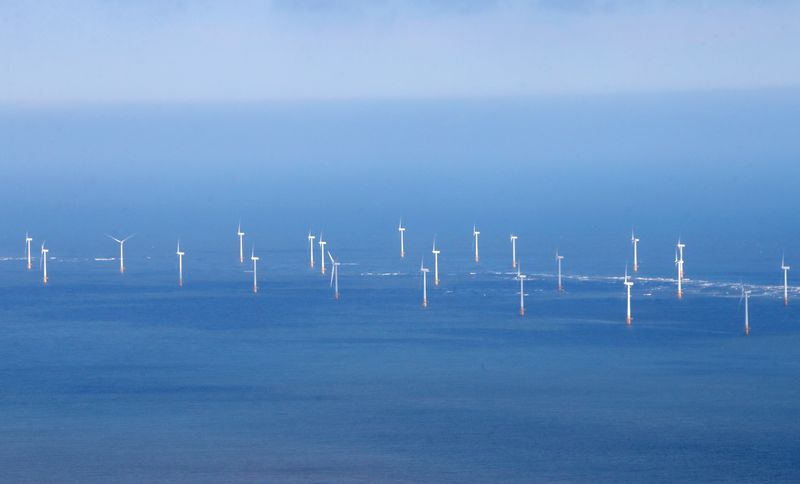By Susanna Twidale
LONDON (Reuters) - Governments have decided to pay up to revive offshore wind farm developments after rising costs put at risk multiple projects that are needed to help them cut emissions and reach climate targets.
Many countries are relying on a huge and rapid build-out of offshore wind farms which have high upfront costs but over the longer term can provide cheaper energy than fossil fuel plants.
But some countries' wind power capacity targets started to look unrealistic this year after developers cancelled projects in the U.S. and Britain because soaring costs made them unprofitable.
Investors told Reuters governments have since shown willingness to pay higher prices, helping to restore confidence in the future of the industry.
"The reality is governments are starting to react and are accepting that to keep their offshore wind programmes on track - which are important for the economy, energy security, decarbonisation targets and jobs - its worth paying a bit more,” said Jonathan Cole, CEO of project developer Corio Generation.
Corio, along with TotalEnergies (LON:TTEF) and Rise Light and Power in October were successful in an auction held by New York State for their Attentive Energy One 1.4 gigawatt (GW) offshore wind project, part of a wider procurement of 6.4 GW of renewable capacity, enough to power around 2.6 million homes.
Data from the New York State Energy Research and Development Authority (NYSERDA), which runs the state's renewable auctions, said the average strike price, or contract offered in the auction result, announced in October, was around 28% higher than the earlier auctions held in 2018 and 2020 and equated to a nominal weighted average strike price of $145.07 per megawatt hour.
Corio's Cole said the higher price was based on the realities of the market currently.
In Britain, the world's second largest offshore wind market behind China, developers can bid for government-backed price guarantees for the electricity produced, called Contracts for Difference (CfDs).
If wholesale prices are lower than the so-called strike price agreed in the CfD, the government makes up the difference, giving project developers long-term revenue certainty. If prices are higher, the developer pays back the difference to the UK government.
Britain's last auction in September failed to attract any offshore wind projects, with developers saying the guaranteed price on offer was too low. Since then, the government has said it would offer contracts with a price 66% higher at the next auction due to be held in 2024.
Keith Anderson, CEO of Iberdrola-owned Scottish Power, said the increase showed Britain’s government had listened to industry concerns and such a move would be likely to prevent the kind of write-downs that some companies have had to make for U.S. projects.
In Britain, before companies can bid in CfD auctions they must already have met certain criteria. As a result, Anderson said companies could have sunk 500 million pounds ($631.15 million) into projects before even getting to the auction stage.
Without enough incentive "you run the risk of companies having to write off projects, you run the risk of supply chain contracts being cancelled, then the supply chain loses confidence and you run the risk of investors losing confidence," Anderson said.
Analysts at Aurora Energy Research said the higher British contract price would mean that for a generic project, developers could generate returns of up to 13.9% compared with returns of just 4% achievable under the terms offered in the failed auction.
"Crucially ... it is becoming economic for projects to build at such prices," said Marc Hedin Head of Research, UK & Ireland at Aurora.
He said that even with the higher UK strike price the cost of offshore wind broadly remains cheaper than efficient new gas plants.
UPFRONT COSTS
Offshore wind projects do have high upfront costs. Orsted's 3 GW Hornsea 3 project, planned off the coast of Britain, is expected to cost around 8 billion pounds.
Yet once the projects are built, they have no fuel costs and over the longer term provide a cheaper alternative to fossil fuels.
"In the longer-term we see countries with more wind and solar will have cheaper wholesale electricity prices than those relying more on fossil fuels," said LSEG analyst Nathalie Gerl.
Despite the uncertainty created by the recent setbacks, investor appetite for offshore wind is strong.
Britain's Octopus launched a dedicated fund with Japan's Tokyo Gas (9531.T) to invest 3 billion pounds ($3.7 billion) in offshore wind projects by 2030.
Germany's RWE (LON:0HA0) said it would raise its offshore wind capacity from 3.3 GW currently to 10 GW by the end of the decade. On Friday the company announced plans to develop a new 3 GW British offshore wind farm with the UAE’s clean energy developer, Masdar.
Governments too, it seems, recognise that it makes sense to stick with the technology as one of the fastest ways to rapidly scale up their renewable power and meet climate targets.
Soeren Lassen, head of offshore wind Research at WoodMac said more than 50 GW of offshore wind tenders globally are planned for 2024.
"It's just a question of the policymakers making them attractive enough and for the industry to seize those opportunities," he said.
($1 = 0.7922 pounds)
